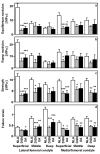Biomechanical, structural, and biochemical indices of degenerative and osteoarthritic deterioration of adult human articular cartilage of the femoral condyle
- PMID: 19464244
- PMCID: PMC2763930
- DOI: 10.1016/j.joca.2009.04.017
Biomechanical, structural, and biochemical indices of degenerative and osteoarthritic deterioration of adult human articular cartilage of the femoral condyle
Abstract
Objective: To compare the tensile biomechanical properties of age-matched adult human knee articular cartilage exhibiting distinct stages of degenerative or osteoarthritic deterioration and to determine the relationships between tensile properties and biochemical and structural properties hypothesized to underlie functional biomechanical deterioration.
Methods: Age-matched articular cartilage samples, obtained from the lateral and medial femoral condyles (LFC and MFC), exhibited (1) minimal fibrillation, characteristic of normal aging (NLA), (2) overt fibrillation associated with degeneration (DGN), or (3) overt fibrillation associated with osteoarthritis (OA). DGN samples were from knees that exhibited degeneration but not osteophytes while OA samples were from fragments removed during total knee arthroplasty. Cartilage samples were analyzed for tensile properties, cell and matrix composition, and histopathological structure.
Results: Differences in tensile, compositional and surface structural properties were indicative of distinct stages of cartilage degeneration, early (OA) advanced (DGN) and late (OA) with early degenerative changes in NLA samples being more advanced in the MFC than the LFC, including higher surface fibrillation, lower intrinsic fluorescence, and lower mechanical integrity. The transition from early to advanced degeneration involved a diminution in mechanical function, surface integrity, and intrinsic fluorescence. The transition from advanced to late degeneration involved an increase in cartilage water content, an increase in degraded collagen, and loss of collagen.
Conclusions: These results provide evidence of coordinated mechanical dysfunction, collagen network remodeling, and surface fibrillation. Even in the cartilage of knees exhibiting overt fibrillation but not extensive erosions characteristic of clinical osteoarthritis, most features of advanced cartilage degeneration were present.
Figures





References
-
- Praemer A, Furner S, Rice DP. Musculoskeletal Conditions in the United States. Park Ridge, IL: American Academy of Orthopaedic Surgeons; 1999.
-
- Temple MM, Bae WC, Chen MQ, Lotz M, Amiel D, Coutts RD, et al. Age- and site-associated biomechanical weakening of human articular cartilage of the femoral condyle. Osteoarthritis Cartilage. 2007;15:1042–1052. - PubMed
-
- Akizuki S, Mow VC, Muller F, Pita JC, Howell DS, Manicourt DH. Tensile properties of human knee joint cartilage: I. influence of ionic conditions, weight bearing, and fibrillation on the tensile modulus. J Orthop Res. 1986;4:379–392. - PubMed
-
- Kempson GE, Muir H, Pollard C, Tuke M. The tensile properties of the cartilage of human femoral condyles related to the content of collagen and glycosaminoglycans. Biochim Biophys Acta. 1973;297:456–472. - PubMed
Publication types
MeSH terms
Substances
Grants and funding
LinkOut - more resources
Full Text Sources
Medical

